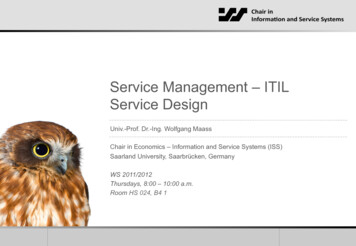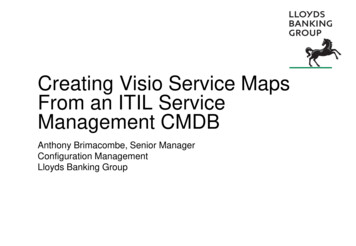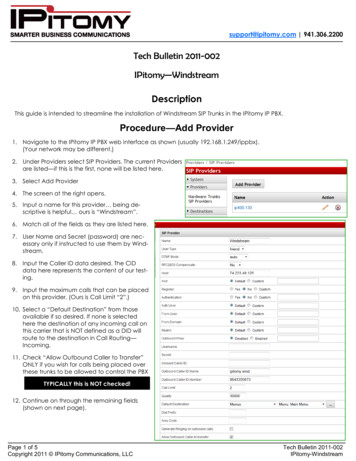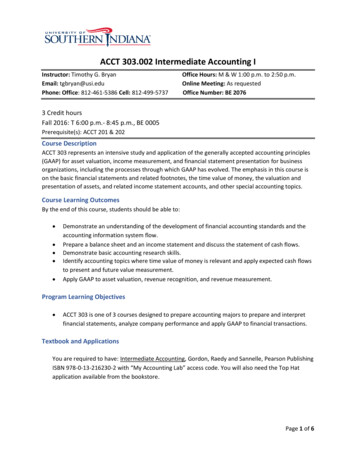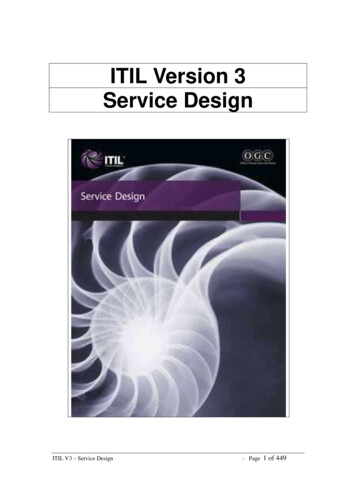
Transcription
ITIL Version 3Service DesignITIL V3 – Service Design- Page 1 of 449
The ITIL Core consists of five publications. Each providesthe guidance necessary for an integrated approach, asrequired by the ISO/IEC 20000 standard specification: Service StrategyService DesignService TransitionService OperationContinual Service Improvement.ITIL V3 – Service Design- Page 2 of 449
I N D I C EForeword.10OGC’s foreword . 10Chief Architect’s foreword. 10Preface .12Contact information. 13Acknowledgements.14Chief Architect and authors . 14ITIL authoring team. 14Mentors . 14Further contributions . 15The ITIL Advisory Group . 15Reviewers . 151 Introduction .161.1 Overview . 171.2 Context. 191.2.1 Service Management. 191.2.2 Good practice in the public domain . 191.2.3 ITIL and good practice in Service Management. 211.2.3.1 Service Strategy.231.2.3.2 Service Design.231.2.3.3 Service Transition .241.2.3.4 Service Operation .241.2.3.5 Continual Service Improvement .241.3 Purpose. 251.4 Usage. 252 Service Management as a practice.262.1 What is Service Management? . 262.2 What are services? . 282.2.1 The value proposition . 282.3 Functions and processes across lifecycle. 292.3.1 Functions . 292.3.2 Processes. 292.3.3 Specialization and coordination across the lifecycle . 302.4 Service Design fundamentals. 312.4.1 Purpose/goal/objective . 312.4.2 Scope. 312.4.3 Value to business . 382.4.4 Optimizing design performance. 382.4.5 Processes within Service Design . 393 Service Design principles.413.1 Goals. 443.2 Balanced design . 453.3 Identifying service requirements. 483.4 Identifying and documenting business requirements and drivers . 503.5 Design activities . 523.6 Design aspects . 54ITIL V3 – Service Design- Page 3 of 449
3.6.1 Designing service solutions. 553.6.2 Designing supporting systems, especially the Service Portfolio . 573.6.3 Designing technology architectures . 623.6.3.1 Technology Management.693.6.4 Designing processes . 743.6.5 Design of measurement systems and metrics . 763.7 The subsequent design activities . 803.7.1 Evaluation of alternative solutions. 803.7.2 Procurement of the preferred solution. 803.7.3 Develop the service solution . 813.8 Design constraints . 823.9 Service Oriented Architecture. 843.10 Business Service Management. 853.11 Service Design models. 873.11.1 Delivery model options . 873.11.2 Design and development options . 893.11.3 Design and development approaches. 923.11.3.1 Rapid Application Development .923.11.3.2 Off-the-shelf solutions .954 Service Design processes .984.1 Service Catalogue Management . 1014.1.1 Purpose/goal/objective . 1014.1.2 Scope. 1014.1.3 Value to the business . 1014.1.4 Policies, principles and basic concepts . 1024.1.5 Process activities, methods and techniques . 1054.1.6 Triggers, inputs, outputs and interfaces . 1064.1.7 Information management. 1064.1.8 Key Performance Indicators . 1074.1.9 Challenges, Critical Success Factors and risks . 1074.2 Service Level Management . 1094.2.1 Purpose/goal/objective . 1094.2.2 Scope. 1104.2.3 Value to the business . 1104.2.4 Policies/principles/basic concepts . 1114.2.5 Process activities, methods and techniques . 1124.2.5.1 Designing SLA frameworks.1144.2.5.2 Determine, document and agree requirements for new services and produce SLRs .1164.2.5.3 Monitor service performance against SLA .1184.2.5.4 Collate, measure and improve customer satisfaction.1204.2.5.5 Review and revise underpinning agreements and service scope .1214.2.5.6 Produce service reports .1224.2.5.7 Conduct service reviews and instigate improvements within an overall SIP .1234.2.5.8 Review and revise SLAs, service scope and underpinning agreements.1244.2.5.9 Develop contacts and relationships .1244.2.5.10 Complaints and compliments .1254.2.6 Triggers, inputs, outputs and interfaces . 1264.2.6.1 SLM process inputs .1264.2.6.2 SLM process outputs .1274.2.7 Key Performance Indicators . 1284.2.7.1 KPIs .1294.2.8 Information Management. 1304.2.9 Challenges, Critical Success Factors and risks . 1304.2.9.1 Critical Success Factors.1334.3 Capacity Management. 1344.3.1 Purpose/goal/objective . 1344.3.2 Scope. 134ITIL V3 – Service Design- Page 4 of 449
4.3.3 Value to the business . 1374.3.4 Policies/principles/basic concepts . 1384.3.4.1 Business Capacity Management.1404.3.4.2 Service Capacity Management .1404.3.4.3 Component Capacity Management.1404.3.5 Process activities, methods and techniques . 1414.3.5.1 Business Capacity Management.1424.3.5.2 Service Capacity Management .1454.3.5.3 Component Capacity Management.1464.3.5.4 The underpinning activities of C
ITIL V3 – Service Design - Page 2 of 449 The ITIL Core consists of five publications. Each provides the guidance necessary for an integrated approach, as required by the ISO/IEC 20000 standard specification : Service Strategy Service Design
